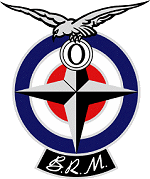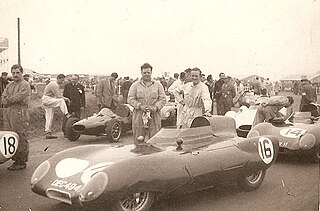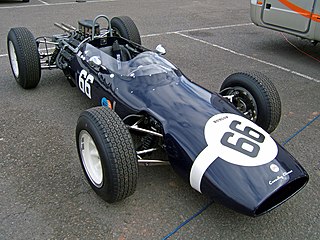
The Brabham BT5, and its evolution, the Brabham BT8, are sports racing cars manufactured and developed by Brabham in 1963 (BT5) and 1964 (BT8), respectively. It won a total of 4 races, and achieved 10 podium finishes. [1] [2] [3]

The Brabham BT5, and its evolution, the Brabham BT8, are sports racing cars manufactured and developed by Brabham in 1963 (BT5) and 1964 (BT8), respectively. It won a total of 4 races, and achieved 10 podium finishes. [1] [2] [3]
After having worked to enter the competitions reserved for Formula One and Formula Junior, Brabham decided to dedicate itself also to the construction of racing cars with covered wheels. The result of this was the creation, in 1963, of the BT5, which was intended for private riders. Two examples were built.
The BT5 employed numerous components derived from open-wheeled cars. The chassis, covered with a fiberglass body, was multi-tubular in a spaceframe configuration, while the suspension was double wishbones in the front section, while in the rear it was double wishbones. The engine that equipped it was a Ford-Cosworth 116E Mk.XII 1.6 twin-shaft 140 hp (100 kW) engine mated to a four-speed Hewland manual gearbox. The braking system consisted of four disc brakes. [4] [5] [6]
To allow it to accommodate larger engines, the BT5 underwent an enlargement in 1964 and was renamed BT8. A 245 hp Coventry Climax FPF engine was used. One example was equipped with a BRM P56 V8 engine. [7] [8] [9]
The first vehicle was initially delivered to Ian Walker's team, who deployed it at Snetterton piloted by Frank Gardner and Paul Hawkin. Thanks to them the BT5 obtained the class victory, and this also happened at the Guards Trophy held at Brands Hatch. It was later sold to Peter Sachs who took it to several North American races. The second model was bought instead by the Canadian driver Ed Zeller, who achieved several successes in European competitions.
In 1964, with the introduction of the upgraded BT8 version, Brabham achieved notable results such as the conquest of the 1965 Tourist Trophy by Denny Hulme. Another important result was the conquest of the class victory and the third place overall at the Levant Cup on the Goodwood circuit by Jack Brabham on the BT8 of the US team Rosebud powered by BRM. [10] [11] [12]

British Racing Motors (BRM) was a British Formula One motor racing team. Founded in 1945 and based in the market town of Bourne in Lincolnshire, it participated from 1951 to 1977, competing in 197 grands prix and winning seventeen. BRM won the constructors' title in 1962 when its driver Graham Hill became world champion. In 1963, 1964, 1965 and 1971, BRM came second in the constructors' competition.
The Ferrari P was a series of Italian sports prototype racing cars produced by Ferrari during the 1960s and early 1970s.

Ginetta Cars Limited is a British specialist builder of racing and sports cars based in Garforth, Leeds, West Yorkshire.

The Maserati Tipo 151 is a racing car manufactured by Italian automobile manufacturer Maserati for the 1962 LeMans season to compete in the experimental GT car class. Three cars were built in total, one for Johnny Simone of Maserati France with a red exterior colour and white tri-stripes whilst two were built for Briggs Cunningham for his racing team. These cars had a white body with two blue stripes.

The Eagle Mk1, commonly referred to as the Eagle T1G, was a Formula One racing car, designed by Len Terry for Dan Gurney's Anglo American Racers team. The Eagle, introduced for the start of the 1966 Formula One season, is often regarded as being one of the most beautiful Grand Prix cars ever raced at the top levels of international motorsport. Initially appearing with a 2.7L Coventry Climax inline 4-cylinder engine, the car was designed around a 3.0L Gurney-Weslake V12 which was introduced after its first four races. In the hands of team boss Gurney, the Eagle-Weslake won the 1967 Belgian Grand Prix, making Dan Gurney only the second driver at the time, and one of only three to date, to win a Formula One Grand Prix in a car of their own construction. Excluding the Indianapolis 500, that win in Belgium still stands as the only win for a USA-built car as well as one of only two wins of an American-licensed constructor in Formula One. It was also the first win for an American constructor in a Grand Prix race since the Jimmy Murphy's triumph with Duesenberg at the 1921 French Grand Prix.

The BRM P261, also known as the BRM P61 Mark II, is a Formula One motor racing car, designed and built by the British Racing Motors team in Bourne, Lincolnshire, England. The BRM P261 was introduced for the 1964 Formula One season, and its design was an evolution of Tony Rudd's one-off BRM P61 car of 1963. The P261 had a relatively long racing career; variants of the car were still being entered for Formula One World Championship Grands Prix as late as 1968. During the course of their front-line career, BRM P261s won six World Championship races, in the hands of works drivers Graham Hill and Jackie Stewart, and finished second in both the Drivers' and Constructors' Championship standings in 1964 and 1965. Stewart, Hill and Richard Attwood also used works P261s to compete in the Tasman Series in 1966. The BRMs dominated, with Stewart winning four, Hill two, and Attwood one of the 1966 Tasman Series' eight races. Stewart also won the title. The works-backed Reg Parnell Racing team returned in 1967 with Stewart and Attwood, where Stewart added another two wins to his tally. In terms of races won and total championship points scored, the P261 was the most successful car in BRM's history.

The Honda RA271 was Honda's first Formula One racing car to enter a race. The chief engineer on the project was Yoshio Nakamura, with Tadashi Kume in charge of engine development. It was driven in three races during 1964 by American driver Ronnie Bucknum.

The Brabham BT3 is a Formula One racing car. It was the first Formula One design to be produced by Motor Racing Developments for the Brabham Racing Organisation, and debuted at the 1962 German Grand Prix. The Brabham BT3 was the vehicle with which team owner – then two-time World Champion – Jack Brabham, became the first driver ever to score World Championship points in a car bearing his own name, at the 1962 United States Grand Prix. The following year Brabham also became the first driver ever to win a Formula One race at the wheel of an eponymous car, again driving the BT3, at the 1963 Solitude Grand Prix. The BT3 design was modified only slightly to form the Tasman Series-specification Brabham BT4 cars.

John Crosthwaite was an English race car designer and engineer, active in both the United Kingdom and the United States.

The Brabham BT23 was a formula racing car built by Brabham in 1967.

The BRM P48 was a Formula One racing car raced in 1960. It was BRM's first rear-engined car. With rear-engined cars in the ascendancy, BRM hastily reworked the front-engined, now five-year-old P25. The car proved to be slow and unreliable, and was replaced by the P48/57 the following year.

The Brabham BT7 is a Formula One racing car. It was raced by the Brabham Racing Organisation and several privateers from 1963 to 1966. A development of its predecessor, the Brabham BT3, the car proved to be competitive during 1963 and 1964, taking Dan Gurney to two victories. Technical issues prevented the BT7 from scoring better results. The car was equipped with a more reliable Hewland gearbox compared to the Colotti-Francis in the BT3. Malcolm Sayer from Jaguar Cars was consulted to give input for the revised chassis. The slick aerodynamics proved particularly strong at high speed circuits such as Monza or Spa. Its successor, the BT11, was a slightly altered BT7 aimed for customers such as Rob Walker or Jo Siffert.

The Cooper T66 is a Formula One racing car from the Cooper Car Company, which was in use from 1963 to 1964.

The Brabham BT2 is an open-wheel racing car made by Brabham in 1962.

The Cooper-Climax T55 is a Formula One car built by the Cooper Car Company for the 1961 Formula One season. Its best result was third-place for Bruce McLaren at the 1961 Italian Grand Prix.

The Brabham BT45 was a Formula One car designed by South African engineer Gordon Murray for the 1976, 1977 and 1978 Formula One seasons.

The RAM 01, also known as the RAM March 01, is an open-wheel Formula One race car built by British team and constructor RAM Racing in 1983.

The Cooper T39, nicknamed the "Bob-Tail", is a successful lightweight, mid-engined, sports car, designed and developed by Owen Maddock at Cooper Cars, for sports car racing in 1955. The car debuted in active racing competition at the Easter race in Thruxton in 1955, being driven by Ivor Bueb, and was later entered into the 1955 24 Hours of Le Mans, being driven by John Brown and Edgar Wadsworth, but was unfortunately not classified, because even though the car managed to complete 207 laps around the 8.4-mile Le Mans circuit, it didn't manage to finish within 70% of the winners' race distance. However, between 1956 and 1962, it did manage to rack up and tally an incredible streak of domination and competitiveness, scoring 91 total wins and clinching 236 podiums finishes; an incredible record. It was powered by the 1,098 cc (67.0 cu in) Coventry-Climax four-cylinder engine.

The Chevron B16 was a Group 4 sports prototype race car, designed, developed, and built in 1969 by the British racing car manufacturer Chevron Cars as a two-seater racing sports car for the makes world championship. Brian Redman won the very first outing, the 500 km (310 mi) race at the Nürburgring on September 7, 1969, at a time of 3:13:01.6 hours. The last victory with a Chevron B16 was achieved by Clemens Schickentanz on July 11, 1971, in the sports car race at the Norisring.

The Connaught Type A was a Formula Two race car, designed, developed, and built by British manufacturer Connaught Engineering in 1950 and used until the late 1950s.